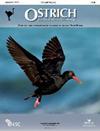2021年1月在南非罗本岛和朱滕岛获救的角鸬鹚的护理和康复成功初步评估
IF 1.1
4区 生物学
Q2 ORNITHOLOGY
引用次数: 0
摘要
在过去的三十年里,濒临灭绝的Cape Cormorant Phalacrocorax capensis的数量减少了一半以上(国际鸟盟2018a)。2021年1月,在两个重要的筑巢地发现了近2000只因脱水和热应激而被遗弃的开普Cormorant雏鸟。南部非洲海岸鸟类保护基金会(南非开普敦SANCCOB)对这些小鸡进行了救助和修复。大约一半(53.7%)的cormorant雏鸟成功康复,并被放归繁殖地。这项研究发现,被收容到康复中心的cormorant雏鸟的初始体重与其在康复期间存活的概率之间存在直接联系,最初体重较重的鸟最终被释放的概率更大。大多数死亡的cormorant雏鸟(80.7%)在入院后的前5天内死亡。这次救援需要SANCCOB一次性照顾和恢复有史以来入住其康复中心的数量最多的开普Cormorant雏鸟,这是第一次此类救援。尽管可能对开普珊瑚虫的总体种群数量产生的积极影响有限,但救援活动提高了SANCCOB的准备能力,以成功应对未来的灾难事件,并应对当地和全球的不同物种。本文章由计算机程序翻译,如有差异,请以英文原文为准。
Initial evaluation of the care and rehabilitation success of Cape Cormorants Phalacrocorax capensis rescued from Robben and Jutten islands, South Africa, in January 2021
The population of the endangered Cape Cormorant Phalacrocorax capensis more than halved over the last three decades (BirdLife International 2018a). In January 2021, nearly 2 000 Cape Cormorant chicks were found abandoned, suffering from dehydration and heat stress, at two important nesting sites. The chicks were rescued and rehabilitated by the Southern African Foundation for the Conservation of Coastal Birds (SANCCOB, Cape Town, South Africa). About half (53.7%) of the cormorant chicks were successfully rehabilitated and released back into the breeding colonies. This study found a direct link between the initial body mass of cormorant chicks admitted to the rehabilitation centre and their probability of surviving during rehabilitation, with birds that were initially heavier having a greater probability of eventual release. Most cormorant chicks that died (80.7%) did so within the first 5 days of admission. This rescue required SANCCOB to care for and rehabilitate the largest number of Cape Cormorant chicks that has ever been admitted to its rehabilitation centre at one time, making it the first rescue of its kind. Despite the presumably limited positive impact on overall population numbers of Cape Cormorants, the rescue campaign improved SANCCOB’s preparedness to respond successfully to future disaster events and to deal with different species, both locally and globally.
求助全文
通过发布文献求助,成功后即可免费获取论文全文。
去求助
来源期刊

Ostrich
生物-鸟类学
CiteScore
2.10
自引率
30.00%
发文量
24
审稿时长
>12 weeks
期刊介绍:
Ostrich: Journal of African Ornithology is the leading ornithological journal in Africa, and publishes peer-reviewed scientific papers and short communications (
 求助内容:
求助内容: 应助结果提醒方式:
应助结果提醒方式:


